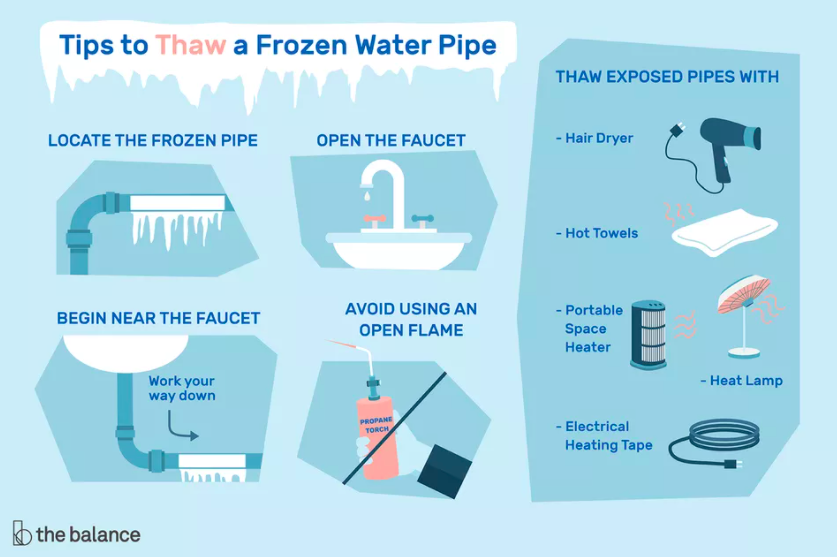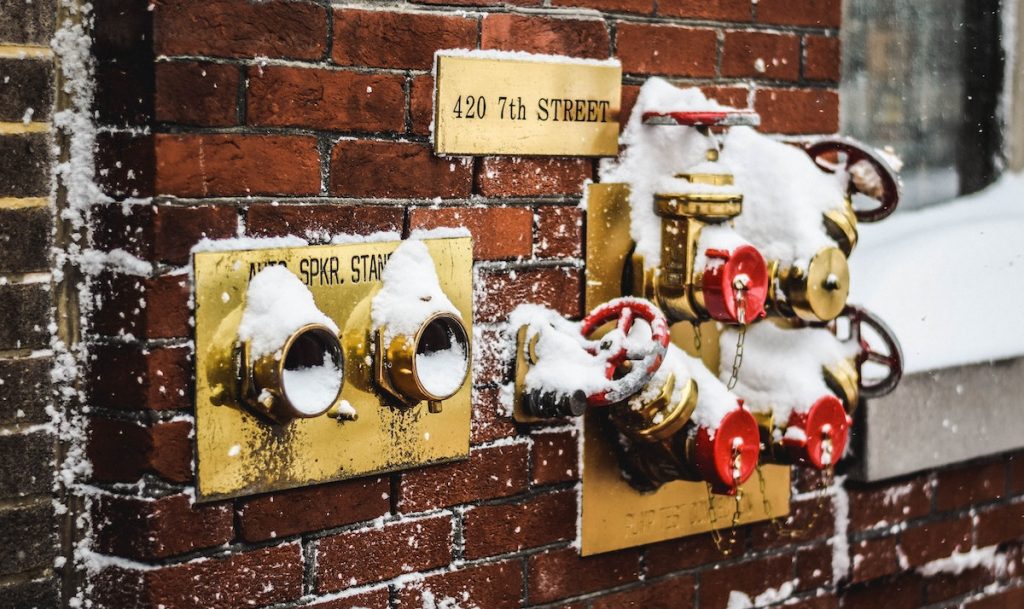The winter weather creates different problems for your home, many of which are due to ice buildups. Hail shatters the windows, ice dams ruin your gutter and frozen pipes present a plumbing nightmare. Most homeowners are surprised by the third problem. After all, pipes are located underground, far away from the winter. How could they be frozen?
But it happens. During the cold and winter season, you’ll wake up to no water due to frozen pipes.
No matter how many times you’ve dealt with frozen pipes, it’s never easy. Plus, many questions come to mind: why are my pipes frozen? How to thaw frozen pipes situated underground? Will frozen pipes thaw on their own? Are there any home maintenance tips that work?
Frozen pipes pose a dilemma to the busy homeowner, but don’t worry. We’ll teach you how to thaw frozen pipes underground (as well as those that are exposed or located behind the wall), as well as walk you through preventive and maintenance practices.
- Why Do Pipes Freeze in the First Place?
- How Cold Does it Have to be for Pipes to Freeze?
- How Do You Thaw Frozen Pipes You Can’t Reach?
- More Tips on How to Thaw Frozen Pipes Underground
- What to Do Once the Pipes Start to Thaw
- Will a Frozen Pipe Thaw on its Own?
- How to Prevent Pipes Underground From Freezing?
Why Do Pipes Freeze in the First Place?
When the weather is cold enough, there are two ways your underground pipes can freeze. First, when a small amount of water freezes and clogs the pipeline, this leads to a build up of pressure, especially when the water remains confined within the pipeline.
Another reason is the water freezing inside of the pipe. A high volume of water pressed against the pipe’s interior will cause a buildup of water, which creates pressure inside the pipe.
No matter what the cause is, when your pipes freeze underground, you won’t have water to use. If your toilet doesn’t refill or the kitchen faucet doesn’t give water, you have a frozen pipe situation. To confirm the concern:
- Touch pipe surfaces to locate cold spots.
- Tap the pipes with a screwdriver or any small tool to listen for solid sounds.
- Look for a light coat of frost or condensation on your pipes.
How Cold Does it Have to be for Pipes to Freeze?
According to a study from the University of Illinois’s Building Research Council (BRC), non-insulated pipes will start to freeze when the temperature drops to 20 °F (-6.667°C) and below.
Water’s freezing temperature stands at 32°F (0°C), but the ground or building materials surrounding the pipe only offer a small degree of insulation.
How Do You Thaw Frozen Pipes You Can’t Reach?
Thawing out frozen pipes within an underground like can be frustrating. If the frozen pipe is a sewage line, you’ll need help from a plumber. They often recommend excavating the line since any cracks caused by thawing and pressure could contaminate the surrounding soil.
Thawing frozen pipes can be a weekend DIY project. You can do some measures on your own but it’s always best to have a professional by your side.
But if you prefer to DIY this project, here’s how to thaw frozen pipes underground.
- Make sure you have the right tools. You’ll need a gate valve, nylon hose, a large storage bin and a pond pump.
- Fill the bin with water (five gallons should be enough). Any water temperature will do.
- Gain access to the supply pipe by unhooking the water meter.
- Place the bin under the opening of your supply line.
- Attach the gate valve to the supply line. Since water pressure will flow through once you remove the blockage, you have to stop the flow with a valve. But if your pipeline has a valve that you can run the nylon tubing, disregard this step.
- Send water through the hose with your pond pump. Next, insert the hose into the supply line until you reach the blockage.
- Continue working the tube back and forth until you’ve thawed the blockage.
- Once the last blockage breaks, turn the valve off and reconnect the meter before opening the valve again.
More Tips on How to Thaw Frozen Pipes Underground

If you have a minor or a more serious issue with frozen pipes, there are other ways to thaw frozen pipes under your home:
- Turn up your thermostat. This is one of the easiest ways to thaw pipes located underground. By turning the thermostat up, you can melt small ice blockages.
- Use an infrared lamp. If the frozen blockage runs deeper in the pipe, turning up the temperature won’t help. You may need to use an infrared lamp. Place it close to the blocked portion and let the lamp melt the blockage and defrost the pipe.
- Cut out a part of the wall. This is the most invasive method and is often used for more serious problems. By cutting out a small section of the wall or floor, you can thaw the frozen pipe more effectively.
What to Do Once the Pipes Start to Thaw
You did a good job of thawing your pipes if water starts flowing out of your faucet. But there are still a few steps to ensure your plumbing system is OK.
Leave the faucet running for a few minutes. This clears out any of the leftover ice. Once you’re sure there is no ice left, turn off the faucet. If your pipes start leaking due to being frozen in the first place, shut off the main water valve to check the pipes. You can either fix it or replace it with a new one.
Will a Frozen Pipe Thaw on its Own?
Technically, they can but waiting for frozen pipes underground to melt on their own can be risky. As the ice begins to melt, any water caught between the ice and the faucet increases the pressure within the pipe. The increase in pressure can cause the frozen pipes to burst.
How to Prevent Pipes Underground From Freezing?
Any homeowner who has struggled with frozen pipes will tell you the same thing: they never want to experience this again. Once you’ve thawed your frozen pipes, apply some preventive measures. The same concept applies if you have never encountered a frozen plumbing system. As the old saying goes, prevention is better than cure.
Prevent frozen pipes in the future with the following steps:
Insulate Your Home Using Proper Insulation
Specialty insulation protects underground pipes from freezing. Regular house insulation cannot survive underground; once buried, it will compress and lose its ability to warm up the pipes. Compressed insulation loses its intended insulating factor and no longer has the air barrier.
On the other hand, specialty insulation is designed for underground water lines and can effectively prevent pipes from freezing. It offers two to three layers of insulation. Most specialty insulation also uses wire to hold the system in place.
Use Steel Plating
Steel plates are often installed over the waterlines of roadways. They often have two purposes: distributing the vibration from overhead vehicular traffic to prevent damaging the waterline. The vibration from cars can loosen the fittings or cause other serious damages.
Steel plating also prevents damage to future underground work. When the water line is shallow, heavy-duty tools like jackhammers could break the line.
Proper Compaction and Backfill
Cap off your efforts by using proper backfill material and compacting it well. This is a crucial step with any underground installation, especially those with shallow lines.
The type of backfill also matters. For example, soil with high clay content is a poor insulator unlike sand, which has greater insulating properties. Therefore, it’s best to use sand as a backfill material, especially when it comes to shallow water lines. Using sand prevents your underground pipes from freezing.
Other common preventive measures to consider are:
- Covering any exterior faucets to reduce the pipes’ exposure to cold air.
- Disconnecting garden hoses from the spigots before the arrival of the winter season.
- Having your sprinkler system blown out.
- Wrapping the pipe in an insulating material like a pipe sponge.
- Using space heaters or heat lamps in problematic areas during the winter season (but be careful not to let them come into contact with flammable items).
- Burying your pipes as deep as possible. The deeper the pipes are, the warmer they will be.
The next time you wake up and you find out your underground pipes are frozen, don’t panic! There is still hope for your frozen pipes. Just keep the ideas listed below in mind.

